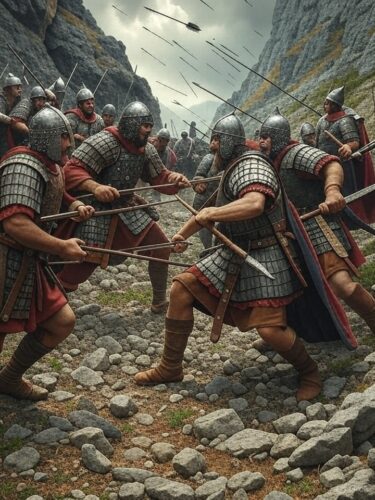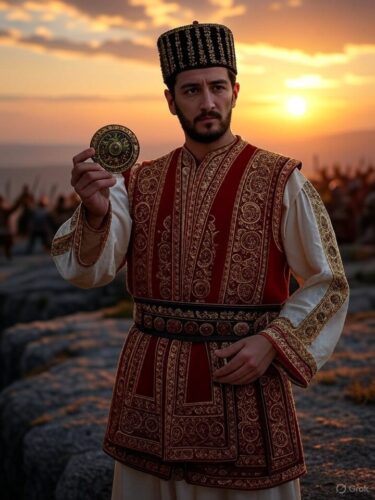Welcome to a journey back in time, where the rugged mountains of Bulgaria hid one of history’s most dramatic ambushes. On August 17, 986 AD, the Battle of the Gates of Trajan unfolded like a scene from an epic saga—complete with emperors, warriors, and a twist of fate that changed the course of empires. This isn’t just a dusty footnote in medieval chronicles; it’s a riveting tale of strategy, survival, and the raw power of terrain. We’ll dive deep into the historical nitty-gritty, exploring the who, what, why, and how with all the vivid details that make history come alive. And then, we’ll bridge the centuries to see how this ancient clash can supercharge your life today. Buckle up—this is going to be informative, packed with facts, and yes, a whole lot of fun as we imagine the clashing swords and thundering hooves.
Let’s set the stage. The year is 986 AD, and the Byzantine Empire, that glittering successor to Rome, is locked in a brutal struggle with the First Bulgarian Empire. The Byzantines, under the young Emperor Basil II, are trying to stamp their authority over the Balkans. Basil, who ascended the throne as a teenager in 976, inherited a realm teeming with intrigue. His predecessors had already chipped away at Bulgarian power: in 971, Emperor John I Tzimiskes captured the Bulgarian capital of Preslav, forced Tsar Boris II to abdicate, and paraded him through Constantinople like a trophy. Eastern Bulgaria fell under Byzantine control, but the west? That’s where the real resistance brewed.
In the western Bulgarian lands, a family of cometopuli (literally “sons of the count”) rose to defy the invaders. These were the four brothers—David, Moses, Aron, and Samuil—sons of Nikola, a high-ranking official from Sredets (modern-day Sofia). They ruled in a unique tetrarchy, dividing the land to better coordinate their fight. By 976, with Tzimiskes dead and Basil distracted by rebellions in Asia Minor (like the uprising led by Bardas Skleros from 976 to 979), the Bulgarians struck back. They reclaimed northeastern Bulgaria, pushed into Thessaly, and even sacked key Byzantine outposts. Larissa fell between 982 and 986, giving them control over vital trade routes.
Basil II couldn’t ignore this forever. At 28 years old, he was eager to prove himself. In the summer of 986, he mustered an army of 15,000 to 20,000 men—knights, infantry, archers, and his elite Varangian guards (Viking mercenaries who’d become a Byzantine staple). His goal? Capture Sredets, the heart of western Bulgaria, to split the enemy territory in two. Marching from Thrace through Plovdiv, Basil’s forces arrived at the fortress in July. What followed was a grueling 20-day siege. The Bulgarians, under Samuil’s command, employed scorched-earth tactics, burning crops and poisoning wells to starve the invaders. A daring sally from the garrison destroyed Byzantine siege engines—catapults, battering rams, the works. Food shortages hit hard; dysentery and morale dips plagued the camp.

Basil called off the siege, his army battered but not broken. Retreat was the only option, back through the Sofia Valley toward Ihtiman and then to Byzantine lands. But Samuil, ever the opportunist, had anticipated this. He’d gathered his forces—numbers unknown, but likely a mix of Slavic warriors, horsemen, and local militias—in the Sredna Gora mountains. The Gates of Trajan, a narrow pass named after the Roman emperor who built a fort there centuries earlier (Trajan’s Gate fortress, dating to the 2nd century AD), was the perfect choke point. Steep cliffs, dense forests, and rocky terrain made it a natural trap.
As the Byzantines retreated, chaos brewed. The rear guard, commanded by Leon Melissenos, peeled off toward Plovdiv, leaving the main force vulnerable. Rumors of Bulgarian ambushes spread like wildfire, causing panic. On August 16, the army camped uneasily. Then, on the 17th, as they funneled into the pass, Samuil struck. Bulgarian forces, positioned on the heights, unleashed a hail of arrows, rocks, and javelins. The Byzantines, crammed in the defile, couldn’t maneuver. Their heavy armor, great for open battles, became a liability in the scramble.
Eyewitness accounts paint a harrowing picture. Leo the Deacon, a Byzantine historian who survived the battle, described the scene: soldiers trampled each other, horses reared in terror, and the air filled with shouts and the clang of metal. Basil’s vanguard managed to slip through unblocked slopes, but the bulk of the army was encircled. An elite unit of Armenian infantry fought ferociously, carving a path for the emperor to escape via side trails. Basil himself barely made it, fleeing with a small escort. The rest? Slaughter. Thousands died—estimates suggest up to two-thirds of the army perished. The imperial insignia, those sacred symbols of Byzantine power, were captured, a humiliation that stung deeply.

The aftermath was immediate and profound. For the Bulgarians, it was a triumph that boosted their momentum. Samuil, now the dominant figure (his brothers David and Moses had died earlier in skirmishes, and Aron was executed for alleged treason), proclaimed himself tsar. He shifted the capital to Ohrid, a lakeside stronghold, and expanded Bulgarian influence. Raids reached Thessaloniki, Edessa, and even the Adriatic coast. Serbia was incorporated, turning Bulgaria into a Balkan powerhouse. The Bitola inscription, carved decades later by Samuil’s nephew Ivan Vladislav, commemorated the victory: “In the year 6494 since the creation of the world [986 AD], this fortress was built… after the great victory over the Greeks.”
For Basil II, the defeat was a nadir. Returning to Constantinople, he faced mockery and unrest. The loss emboldened Bardas Phokas, who launched a rebellion in Asia Minor lasting until 989. Basil had to ally with Vladimir I of Kievan Rus’, trading military aid for a marriage alliance and the conversion of Rus’ to Christianity—a deal that included 6,000 Varangian warriors who helped crush Phokas. This Varangian Guard would become legendary.
But here’s where the story gets even more fascinating: Basil didn’t stay down. He spent the next decades reforming the empire. He curbed the power of landed aristocrats, bolstered the treasury, and rebuilt the army. By 991, he resumed the Bulgarian wars. Key battles followed: the Siege of Vidin in 1002, the Battle of Kleidion in 1014 where he blinded 15,000 Bulgarian prisoners (earning the moniker “Bulgar-slayer”), and finally, the fall of Bulgaria in 1018. Samuil died in 1014, heartbroken by the sight of his blinded men. Bulgaria was annexed, its aristocracy scattered or integrated.
This wasn’t just military conquest; it reshaped the region. Byzantine culture flourished in the Balkans, with Orthodox Christianity spreading deeper. The theme system—administrative divisions with military governors—was extended, securing frontiers. Basil’s reign (976-1025) became the apex of medieval Byzantium, with territories stretching from Armenia to Italy. Yet, the Gates of Trajan scarred him; chroniclers note his lifelong caution in mountain warfare.
Let’s zoom out for more context. The Byzantine-Bulgarian wars spanned centuries, from the 7th century migrations of Slavs and Bulgars into the Balkans. The Bulgars, a Turkic people from the steppes, founded their state in 681 under Khan Asparuh, clashing repeatedly with Constantinople. Peaks included Simeon I’s wars (893-927), where he nearly took the Byzantine capital. By the 10th century, Bulgaria was a Christian kingdom, blending Slavic and Bulgar elements, with its own patriarchate.
The battle’s site, Trayanovi Vrata, echoes Roman legacy. Emperor Trajan (98-117 AD) fortified the pass during his Dacian campaigns, building gates and roads. Ruins still stand today, a UNESCO candidate, drawing hikers and historians. Medieval accounts vary: John Skylitzes and George Kedrenos provide Byzantine perspectives, emphasizing the ambush’s surprise. Armenian historian Stephen of Taron adds details on the Armenian contingent’s heroism. Yahya of Antioch, a Melkite chronicler, notes the loss’s impact on Basil’s prestige.

Delving deeper, consider the tactics. Samuil’s use of terrain foreshadowed guerrilla warfare. The Bulgarians, lighter-armed and mobile, exploited the pass’s bottlenecks—much like Hannibal at Trasimene or Spartans at Thermopylae. Byzantine heavy cataphracts (armored cavalry) were useless in the crush. Logistics failed too; the 20-day siege depleted supplies, forcing the retreat at the worst time—late summer, when mountain streams were low but heat exhausted troops.
Socially, the battle reflected feudal dynamics. Basil’s army included thematic troops (local militias) and tagmata (professional units), but morale was low after the siege. Bulgarian society, post-conversion to Christianity in 864, unified under Orthodoxy, fueling resistance. Women and clergy supported the war effort, as inscriptions show.
Economically, victory allowed Bulgaria to control trade routes from the Danube to the Aegean. Silver mines in the region funded armies. For Byzantium, the loss strained the fisc, leading to tax reforms under Basil.
Culturally, the event inspired folklore. Bulgarian epics celebrate Samuil as a hero, while Byzantine art depicts him as a foe. The blinding at Kleidion, a direct response to earlier humiliations, became infamous—Dante even referenced it in Inferno.
Now, fast-forward to 1018: Bulgaria conquered, but its spirit endured. Descendants like the Asen brothers rebelled in 1185, founding the Second Bulgarian Empire. Byzantium, weakened by internal strife, fell to Crusaders in 1204.

Historians debate the battle’s scale. Some estimate Byzantine losses at 12,000-15,000, others lower. The exact location—near Ihtiman—has been excavated, revealing arrowheads and bones. Modern Bulgaria honors it with monuments, tying into national identity.
This clash wasn’t isolated; it mirrored broader medieval trends: the rise of feudalism, the spread of Christianity, and the clash of empires. Basil’s recovery shows how personal grit can turn tides— he ruled 49 years, dying at 67 while planning another campaign.
And that’s the hook for us today. The Battle of the Gates of Trajan teaches resilience. Basil’s defeat could have ended him, but he adapted, learned, and conquered. In our fast-paced world, setbacks are inevitable—job losses, failed relationships, health crises. But like Basil, we can rebound stronger.
Here’s how this historical fact benefits you today:
– **Career Setbacks:** If a project flops or you’re passed over for promotion, channel Basil’s reform spirit. Assess what went wrong (like his siege logistics), upskill (he built alliances), and strike back with a better plan.
– **Personal Relationships:** After a breakup or argument, don’t retreat into isolation. Basil allied with former foes (like the Rus’); reach out, rebuild trust, and emerge with stronger bonds.
– **Health Challenges:** Facing illness? Basil endured physical and mental tolls post-battle. Adopt his long-game mindset: small, consistent steps like daily exercise or therapy sessions lead to victory.
– **Financial Woes:** Lost money in an investment? Basil reformed taxes post-defeat. Track expenses, diversify, and build an emergency fund to weather storms.
– **Creative Blocks:** Writers or artists hitting walls? The battle’s ambush was a surprise; pivot creatively, seek new inspirations, and turn “defeat” into breakthrough art.
To apply this, follow this 7-day plan:
– **Day 1: Reflect on Defeat.** Journal a recent setback, analyzing causes like Basil did after the battle.
– **Day 2: Gather Allies.** Connect with mentors or friends for advice, mirroring Basil’s Varangian recruitment.
– **Day 3: Build Skills.** Learn one new thing related to your goal—online course, book, or practice.
– **Day 4: Strategize Terrain.** Identify your “mountain pass”—obstacles—and plan routes around them.
– **Day 5: Take Small Action.** Execute a tiny step toward recovery, building momentum.
– **Day 6: Celebrate Wins.** Note progress, like Bulgarians did with inscriptions.
– **Day 7: Long-Term Vision.** Outline a 1-year plan, inspired by Basil’s 30-year comeback.

There you have it—a deep dive into a pivotal moment that shaped empires, wrapped with timeless motivation. History isn’t just dates; it’s a playbook for life. Go forth and conquer your own gates!

